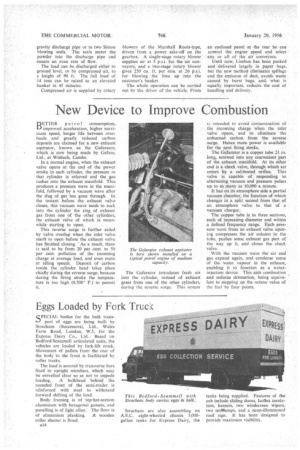New Device to Improve Combustion
Page 48

If you've noticed an error in this article please click here to report it so we can fix it.
BETTER petrol consumption, improved acceleration, higher maximum speed, longer life between overhauls and greatly reduced carbon deposits are claimed for a new exhaust aspirator, known as the Gefarator, which, is now being made by Gefare, Ltd., at Wisbech, Cambs.
In a normal engine, when the exhaust valve opens at the end of the power stroke in each cylinder, the pressure in that cylinder is relieved and the gis rushes into the exhaust manifold. This produces a pressure wave in the manifold, followed by a vacuum wave after the slug of gas has gone through. In the instant before the exhaust valve closes, this vacuum wave tends to suck into the cylinder the slug of exhaust gas from one of the other cylinders, the exhaust valve of which is meanwhile starting to open.
This reverse surge is further aided by valve overlap when the inlet valve start .4 to open before the exhaust valve has finished closing. 'As a result, there is said to be from 20 per cent. to 50 per cent. pollution of the incoming charge at average load, and even more at idling speeds. Deposit of carbon inside the cylinder head takes place chiefly during the reverse surge, because during the firing stroke the temperature is too high (4,500° 'F.) to permit it. The Gefarator introduces fresh air into the cylinder, instead of exhaust gases from one of the other cylinders, during the reverse surge. This system
ti intended to avoid contamination of the incoming charge when the inlet valve opens, and to eliminate the unburned carbon from the reverse surge. Hence more power is available for the next firing stroke.
The Gefarator is a copper tube 21 in. long, screwed into any convenient part of the exhaust manifold. At its other end is a check valve, through which air enters by a calibrated orifice. This valve is capable of responding to alternating vacuum and pressure pulses up to as many as 10,000 a minute.
It has on its atmosphere side a partial vacuum chamber, the function of which changes in a split second from that of an atmosphere valve to that of a vacuum charger. .
The copper tube is in three sections, each of increasing diameter and within a defined frequency range. Each pressure wave from an exhaust valve opening compresses the air column in the tube, pushes some exhaust gas part of the way up it, and closes the check valve. .
• With the vacuum wave the air and gas expand again, and condense some of the water vapour in the exhaust, enabling it to function as a waterinjection device. This aids combustion and reduces detonation, being equivalent to stepping up the octane value of the fuel by four points.




































































































